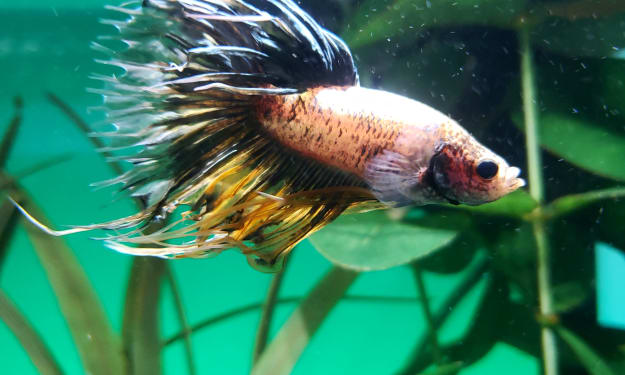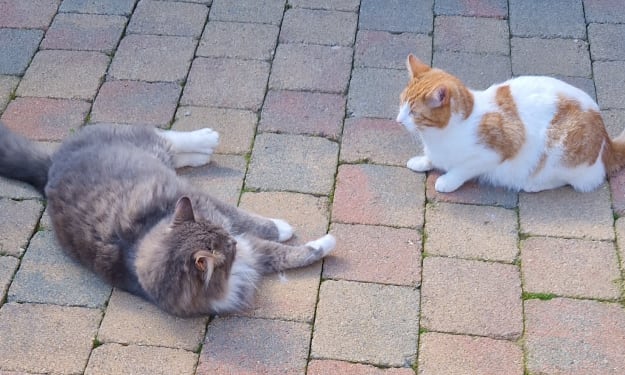
Quick Facts
- Scientific Name: Bitis gabonica
- Common Names: Gaboon Viper, Forest Puff Adder, Whisper, Swampjack, Gaboon Adder, Gabon Viper.
- Geographic Range: Central and Western Africa
- Life Span: 18+ Years
- Conservation Status: Least Concern
1. Gaboon Vipers are not only one of the largest vipers, they also have a unique appearance.
Gaboon vipers have a very unique appearance for a viper. Their colouration can include various gorgeous colours such as light and dark browns, pinks, purples, yellows, blacks and even silvers. They have relatively short tails for their bodies, with broad triangular heads and a narrow neck. Their eye colour can range from creams, yellows, and oranges to a cool silvery colour, and they have two "horns" between raised nostrils.
They are one of the largest vipers in Africa, if not the world. They can weigh more than 40 pounds (25kg) and be up to (or more than!) six feet long (1.8 m).
2. Gaboon Vipers live in the rainforests of Africa.
Gaboon Vipers can be found in rainforests and the wet areas of Central, East, and sometimes West Africa. They are terrestrial snakes, meaning they can be found most often on the forest floor. In fact, their colouration is great at helping them camouflage themselves among the various leaves and debris on the forest floor that they take shelter in. They may occasionally also be found in various swamps and other areas of water.
3. Gaboon Vipers give birth to live young, not eggs.
Unlike many types of snakes, Gaboon Vipers give birth to live babies not eggs. The mother can have up to 50 or 60 babies at a time! Breeding season is around September to December, and the gestation period for the babies can be up to seven months. The offspring are born at approximately 30 cm long, and have no parental involvement after their birth.
4. Gaboon Vipers are carnivores.
Gaboon Vipers are primarily passive hunters, waiting for their prey to walk by them, and then strike with a very fast, precise strike. They hang on to their prey with their fangs, rather than let go of their prey to wait for it to die, as most other vipers do. Their primary food source are various birds which include doves, and mammals such as many types of rodents, hares, and rabbits.
5. Gaboon Vipers are sluggish movers and fairly docile.
Gaboon Vipers are primarily nocturnal, which means they do most of their hunting for food at night. They are mainly ambush predators that wait for their prey to pass by them so they can strike. However some have been found near stables, implying they are possibly out looking for mice.
As mentioned above, Gaboon vipers are extremely sluggish when moving around. They have a slow "walking" motion of the ventral scale when getting around. If threatened they will hiss loudly as a warning, and slightly flatten their head. They primarily count on their warnings as they are unlikely to strike and require extreme provocation before striking. However they are one of the fastest striking vipers, so if one decides to bite you you better watch out.
They also have a wider range of eye movement, allowing them to see a wide degree of their surroundings.
6. Just like all vipers, Gaboon Vipers are venomous.
As with all vipers, Gaboon Vipers are venomous and can cause severe injuries to whatever it may bite. However, bites from Gaboons are rare due to their unaggressive nature and the fact that their range is mainly limited to rainforests away from people. Due to the laziness and sluggishness of Gaboon Vipers, the main cause of bites are due to people accidentally stepping on the snake. However, that does not even guarantee a bite.
If bitten by a Gaboon Viper, it is considered a serious medical emergency as their bites are potentially fatal if not treated. In humans, it can cause rapid swelling, intense pain, severe shock, and local blistering. Other symptoms include uncoordinated movements, soiling yourself, swelling of tongue and eyelids, heart damage, unconsciousness, and bruising and necrosis. So while these snakes may be unaggressive and docile by nature, extreme caution must still be taken when around them.
7. Gaboon Vipers go by various names.
While searching for facts on Gaboon Vipers I have come across many common names for this unique snake. These names include the Gaboon Viper, Forest Puff Adder, Whisper, Swampjack, and Gaboon Adder, and the Gabon Viper.
8. Gaboon Vipers are popular attractions at zoos.
Gaboon Vipers are popular attractions at zoos due to their size and appearance, and general docile behaviour. While at the zoo their diet is made up of mainly mice and rats depending on the size of the viper.
Despite the fact that Gaboon Vipers are venomous, some of the are kept as pets by experienced reptile owners. Obvious care and precaution are needed if you were to own this snake, and they should only be handled by hooks—adults may even need two hooks! They require a good chunk of space due to their large size, and will require close watching as many of these animals for sale are wild caught and may contain parasites.
9. Gaboon Vipers have two different subspecies.
The Gaboon Viper has two different subspecies, which are the East African Gaboon Viper (Bitis. g. gabonica) and the West African Gaboon Viper (Bitis g. rhinoceros). The East African Gaboon Viper is identified by their two small nasal horns, and the two dark triangles beneath each eye. The West African Gaboon Viper has larger nasal horns, and only has a single dark triangle beneath each eye, not two.
10. Gaboon Vipers are often mistaken for another kind of viper.
Gaboon Vipers are occasionally mistaken for another type of similar viper, the Rhinoceros Viper (Bitis nasicornus). While they have a very similar look to them, and are also from Africa, they tend to be a lot more colourful than the Gaboon Viper is.
If you enjoyed this article and want to help us continue our dream of writing, gifts are always welcome.
You can also check out more article like this on our website.
About the Creator
Gracie R.
Owner of the website www.reptileworldfacts.com, and an avid animal lover. Check out our website for more reptile articles and to be able to find all of our socials!
Gifts to help me be able to continue writing are always appreciated.






Comments
There are no comments for this story
Be the first to respond and start the conversation.